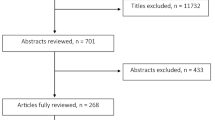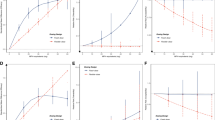Abstract
Background
Stimulant medications have been prescribed to effectively treat childhood Attention Deficit Hyperactivity Disorder (ADHD) since the 1960’s, with improved outcomes observed in the three core symptom domains. Over the course of these decades researchers and clinicians have debated the issue of negative outcomes with regard to later development of substance use disorders (SUD) for these children.
Aims
To chronicle the development of medical and scientific opinion on the subject of SUD outcomes in ADHD and to appraise most recently published research in this sphere.
Methods
A systematic search of the literature was conducted over 4 databases. Removal of duplicates, application of exclusion criteria and inclusion of publications identified through manual and citation-based search yielded 9 papers.
Results
Prescriptions for stimulant medications are increasing worldwide and in tandem the prevalence of stimulant misuse. Much research focuses on non-medical stimulant misuse as a study aid; however, they are also used as recreational drugs with action on dopaminergic neurotransmitter pathways implicated in addiction disorders. Considering the risks and benefits of stimulant prescribing on later SUD development research in recent decades has produced inconsistent results. Current research supports the hypothesis of improved SUD outcomes for young people treated early and intensely, with poorer outcomes for those with less robust treatment histories.
Conclusions
Consideration of the impact that variable treatment trajectories may have on the risk of later SUD development is recommended, with further research potentially leading to the development of different management pathways based on an individual’s multivariate treatment profile.

Similar content being viewed by others
References
Panizzon L (1944) La preparazione di piridile piperidil-arilacetonitrili e di alcuni prodotti di trasformazione (Parte Ia). Helv Chim Acta 27:1748–1756
McCrossin S (1995) Ritalin and attention deficit disorder: history of its use, effects and side effects
Coghill D, Banaschewski T, Zuddas A et al (2013) Long-acting methylphenidate formulations in the treatment of attention-deficit/hyperactivity disorder: a systematic review of head-to-head studies. BMC Psychiatry 13:237
Electronic Medicines Compendium (2020) Summary of product characteristics - Ritalin 10mg [1035]
Newcorn JH, Halperin JM, Jensen PS et al (2001) Symptom profiles in children with ADHD: effects of comorbidity and gender. J Am Acad Child Adolesc Psychiatry 40:137–146
Jensen CM, Steinhausen H (2015) Comorbid mental disorders in children and adolescents with attention-deficit/hyperactivity disorder in a large nationwide study. ADHD Atten Def Hyp Disord 7:27–38
Carroll BC, McLaughlin TJ, Blake DR (2006) Patterns and knowledge of nonmedical use of stimulants among college students. Arch Pediatr Adolesc Med 160(5):481–485
Kenneth S, Martínez L, Martínez D (2017) E. To Study, to party, or both? Assessing risk factors for non-prescribed stimulant use among middle and high school students. J Psychoactive Drugs 49(1):22–30
World Health Organisation (1997) International Statistical Classification of Diseases and Related Health Problems 10th Revision Secondary International Statistical Classification of Diseases and Related Health Problems 10th Revision
Polanczyk G, Rohde LA (2007) Epidemiology of attention-deficit/hyperactivity disorder across the lifespan. Curr Opin Psychiatry 20:386–392
Thomas R, Sanders S, Doust J et al (2015) Jenny Doust. Prevalence of attention-deficit/hyperactivity disorder: a systematic review and meta-analysis. Pediatrics 135(4):e994–e1001
Xu G, Strathearn L, Liu B et al (2018) Twenty-year trends in diagnosed attention-deficit/hyperactivity disorder among US children and adolescents, 1997–2016. JAMA Netw Open 1(4):e181471
Sayal K, Prasad V, Daley D et al (2018) ADHD in children and young people: prevalence, care pathways, and service provision. Lancet 5(2):175–186
Barkley RA (1998) Attention-deficit hyperactivity disorder. A handbook for diagnosis and treatment. 2nd ed. Guilford Press, New York
Biederman J, Mick E, Faraone SV et al (2002) Influence of gender on attention deficit hyperactivity disorder in children referred to a psychiatric clinic. Am J Psychiatry 159:36–42
Biederman J, Faraone SV (2004) The Massachusetts General Hospital studies of gender influences on attention-deficit/hyperactivity disorder in youth and relatives. Psychiatr Clin North Am 27:225–232
National Institute for Health and Care Excellence (2018) Attention deficit hyperactivity disorder: diagnosis and management [NG87]. NICE
Taylor E, Chadwick O, Heptinstall E (1996) Hyperactivity and conduct problems as risk factors for adolescent development. J Am Acad Child Adolesc Psychiatry 35:1213–1226
Moffitt TE (1990) Juvenile delinquency and attention deficit disorder: boys’ developmental trajectories from age 3 to 15. Child Dev 61:893–910
Zuvekas SH, Vitiello B (2012) Stimulant medication use in children: a 12-year perspective. Am J Psychiatry 169(2):160–166
Sites BD, Beach ML, Davis MA (2014) Increases in the use of prescription opioid analgesics and the lack of improvement in disability metrics among users. Reg Anesth Pain Med 39(1):6–12
International Narcotic Control Board (2013) Narcotic drugs technical report: estimated world requirements for 2013 - statistics for 2011 (No. T.13.XI.2). International Narcotics Control Board, New York
Novak SP, Hakansson A, Martinez-Raga J et al (2016) Nonmedical use of prescription drugs in the European Union. BMC Psychiatry 16:274
McCabe SE, West BT, Teter CJ, Boyd CJ (2014) Trends in medical use, diversion, and nonmedical use of prescription medications among college students from 2003 to 2013: connecting the dots patterns and knowledge of nonmedical use of stimulants among college students. Addict Behav 39(7):1176–1182
McCabe SE, Knight JR, Teter CJ, Wechsler H (2004) Non-medical use of prescription stimulants among US college students: prevalence and correlates from a national survey. Addiction. 100:96–106
Wilens T, Zulauf C, Martelon M et al (2016) Nonmedical stimulant use in college students: association with attention-deficit/ hyperactivity disorder and other disorders. J Clin Psychiatry 77(7):940–947
Weyandt LL, Janusis G, Wilson KG et al (2009) Nonmedical prescription stimulant use among a sample of college students: relationship with psychological variables. J Atten Disord 13(3):284–296
DuPont RL, Coleman JJ, Bucher RH, Wilford BB (2008) Characteristics and motives of college students who engage in nonmedical use of methylphenidate. Am J Adddict 17:167–171
Kerley KR, Copes H, Griffin OH (2015) Middle-class motives for non-medical prescription stimulant use among college students. Deviant Behav 36(7):589–603
DeSantis AD, Hane AC (2010) “Adderall is definitely not a drug”: justifications for the illegal use of ADHD stimulants. Subst Use Misuse 45:31–46
Volkow ND, Swanson JM (2003) Variables that affect the clinical use and abuse of methylphenidate in the treatment of ADHD. Am J Psychiatry 160:1909–1918
Spencer TJ, Biederman J, Ciccone PE et al (2006) PET study examining pharmacokinetics, detection and likeability, and dopamine transporter receptor occupancy of short- and long-acting oral methylphenidate. Am J Psychiatry 163:387–395
Martinez-Raga J, Ferreros A, Knecht C et al (2017) Attention-deficit hyperactivity disorder medication use: factors involved in prescribing, safety aspects and outcomes. Ther Adv Drug Saf 8(3):87–99
Williams R, Goodale L, Shay-Fiddler M et al (2004) Methylphenidate and dextroamphetamine abuse in substance-abusing adolescents. Am J Addict / Am Acad Psychiatr Alcohol Addict. 13. 381–9
Bjarnadottir GD, Haraldsson H, Rafnar B et al (2015) Prevalent intravenous abuse of methylphenidate among treatment-seeking patients with substance abuse disorders. J Addict Med 9(3):188–194
Bright GM (2008) Abuse of medications employed for the treatment of ADHD: results from a large-scale community survey. Medscape J Med 10(5):111
Brandon CL, Marinelli M, Baker LK, White FJ (2001) Enhanced reactivity and vulnerability to cocaine following methylphenidate treatment in adolescent rats. Neuropsychopharmacology. 25(5):651–661
Volkow ND, Wang GJ, Newcorn J et al (2007) Depressed dopamine activity in caudate and preliminary evidence of limbic involvement in adults with attention-deficit/ hyperactivity disorder. Arch Gen Psychiatry 64:932–940
Volkow ND, Ding Y, Fowler JS et al (1995) Is methylphenidate like cocaine? Studies on their pharmacokinetics and distribution in human brain. Arch Gen Psychiatry 52:456–463
Heikkila RE, Orlansky H, Cohen G (1975) Studies on the distinction between uptake inhibition and release of 3H-dopamine in rat brain tissue slices. Biochem Pharmacol 24:847–852
Di Chiara GD, Imperato A (1988) Drugs abused by humans preferentially increase synaptic dopamine concentrations in the mesolimbic system of freely moving rats. Proc Natl Acad Sci U S A
Wise RA (1996) Addictive drugs and brain stimulation reward. Annu Rev Neurosci 19:319–340
Sonuga-Barke EJ (2003) The dual pathway model of AD/HD: an elaboration of neuro-developmental characteristics. Neurosci Biobehav Rev 27:593–604
Wilens TE, Faraone SV, Biederman J, Gunawardene S (2003) Does stimulant therapy of attention-deficit/hyperactivity disorder beget later substance abuse? A meta-analytic review of the literature. Pediatrics. 111(1):179–185
Mannuzza S, Klein RG, Truong NL et al (2008) Age of methylphenidate treatment initiation in children with ADHD and later substance abuse: prospective follow-up into adulthood. Am J Psychiatry 165(5):604–609
Humphreys KL, Eng T, Lee SS (2013) Stimulant medication and substance use outcomes. A Meta-analysis. JAMA Psychiatry 70(7):740–749
Groenman AP, Schweren LJS, Weeda W (2019) Stimulant treatment profiles predicting co-occurring substance use disorders in individuals with attention-deficit/hyperactivity disorder. Eur Child Adolesc Psychiatry 28:1213–1222
Zhang-James Y, Chen Q, Kuja-Halkola R et al (2020) Machine-learning prediction of comorbid substance use disorders in ADHD youth using Swedish registry data. J Child Psychol Psychiatry
Brookes K, Xu X, Chen W et al (2006) The analysis of 51 genes in DSM-IV combined type attention deficit hyperactivity disorder: association signals in DRD4, DAT1 and 16 other genes. Mol Psychiatry 11(10):934–953
Mortality GBD (2016) Causes of Death C. Global, regional, and national life expectancy, all-cause mortality, and cause-specific mortality for 249 causes of death, 1980–2015: a systematic analysis for the Global Burden of Disease Study 2015. Lancet. 388:1459–1544
Berger I (2011) Diagnosis of attention deficit hyperactivity disorder: much ado about something. Isr Med Assoc J 13:571–574
Ginsberg Y, Quintero J, Anand E et al (2014) Underdiagnosis of attention-deficit/hyperactivity disorder in adult patients: a review of the literature. Prim Care Companion CNS Disord 16
Loo SK, Barkley RA (2005) Clinical utility of EEG in attention deficit hyperactivity disorder. Appl Neuropsychol 12:64–76
Schonwald A, Lechner E (2006) Attention deficit/hyperactivity disorder: complexities and controversies. Curr Opin Pediatr 18:189–195
Winzer-Serhan UH (2008) Long-term consequences of maternal smoking and developmental chronic nicotine exposure. Front Biosci 13:636–649
Cortese S, Angriman M, Lecendreux M, Konofal E (2012) Iron and attention deficit/hyperactivity disorder: what is the empirical evidence so far? A systematic review of the literature. Expert Rev Neurother 12(10):1227–1240
Availability of data
Not applicable.
Funding
Not applicable.
Author information
Authors and Affiliations
Corresponding author
Ethics declarations
Conflict of interest
The authors declare that they have no conflict of interest.
Ethics approval
Not applicable.
Consent to participate
Not applicable.
Consent for publication
Not applicable.
Code availability
Not applicable.
Additional information
Publisher’s note
Springer Nature remains neutral with regard to jurisdictional claims in published maps and institutional affiliations.
Rights and permissions
About this article
Cite this article
Carolan, D. ADHD stimulant medication misuse and considerations for current prescribing practice: a literature review. Ir J Med Sci 191, 313–320 (2022). https://doi.org/10.1007/s11845-020-02502-1
Received:
Accepted:
Published:
Issue Date:
DOI: https://doi.org/10.1007/s11845-020-02502-1




